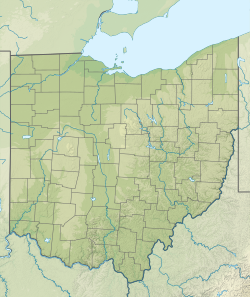
Back ملعب بنك هنتنغتون Arabic FirstEnergy Stadium Danish Huntington Bank Field German Huntington Bank Field Spanish FirstEnergy Stadium (Cleveland) Basque ورزشگاه کلیولند براونز Persian FirstEnergy Stadium Finnish Huntington Bank Field French FirstEnergy Stadium Galician क्लीवलैंड ब्राउन्स स्टेडियम Hindi
 | |
Interior and exterior views in 2021 | |
| Former names | Cleveland Browns Stadium (1999–2013, 2023–2024) FirstEnergy Stadium (2013–2023) |
|---|---|
| Address | 100 Alfred Lerner Way |
| Location | Cleveland, Ohio, U.S. |
| Coordinates | 41°30′22″N 81°41′58″W / 41.50611°N 81.69944°W |
| Public transit | |
| Owner | City of Cleveland |
| Operator | Cleveland Browns |
| Executive suites | 143 |
| Capacity | 67,431 |
| Record attendance | 73,718 (November 3, 2002 vs. Steelers) |
| Surface | Kentucky Bluegrass[1] |
| Construction | |
| Broke ground | May 15, 1997 |
| Opened | September 12, 1999 |
| Construction cost | $283 million ($534 million in 2024 dollars[2])[3] |
| Architect | HOK Sport[4] Robert P. Madison International, Inc.[5] Ralph Tyler Companies[6] |
| Project manager | The Project Group[7] |
| Structural engineer | Osborn Engineering[8] |
| Services engineer | URS Corporation[9] |
| General contractor | Huber, Hunt & Nichols |
| Tenants | |
| Cleveland Browns (NFL) 1999–present | |
| Website | |
| huntingtonbankfield.com | |
Huntington Bank Field is a stadium in Cleveland, Ohio. Primarily for American football. It is the home field of the Cleveland Browns of the National Football League (NFL), and serves as a venue for other events such as college and high school football, soccer, hockey, and concerts. It opened in 1999 as Cleveland Browns Stadium and was known as FirstEnergy Stadium from 2013 to 2023 before briefly reverting to its original name until 2024. The initial seating capacity was listed at 73,200 people, but following the first phase of a two-year renovation project in 2014, was reduced to the current capacity of 67,431. The stadium sits on 31 acres (13 ha) of land between Lake Erie and the Cleveland Memorial Shoreway in the North Coast Harbor area of downtown Cleveland, adjacent to the Great Lakes Science Center and Rock and Roll Hall of Fame. Cleveland Stadium stood on the site from 1931 to 1996.[10][11]
- ^ Newcomb, Tim (September 29, 2015). "Turf time: Which stadiums have the best and worst fields in the NFL?". Sports Illustrated. Retrieved November 2, 2016.
- ^ 1634–1699: McCusker, J. J. (1997). How Much Is That in Real Money? A Historical Price Index for Use as a Deflator of Money Values in the Economy of the United States: Addenda et Corrigenda (PDF). American Antiquarian Society. 1700–1799: McCusker, J. J. (1992). How Much Is That in Real Money? A Historical Price Index for Use as a Deflator of Money Values in the Economy of the United States (PDF). American Antiquarian Society. 1800–present: Federal Reserve Bank of Minneapolis. "Consumer Price Index (estimate) 1800–". Retrieved February 29, 2024.
- ^ "Cleveland Browns Stadium". Ballparks.com. Retrieved October 30, 2012.
- ^ "Stadia Architectural Design". Populous. 2016. Retrieved November 2, 2016.
- ^ "History". Robert P. Madison International, Inc. 2016. Archived from the original on December 13, 2018. Retrieved November 2, 2016.
- ^ "Ralph Tyler". The History Makers. 2016. Retrieved November 2, 2016.
- ^ Cleveland Browns Stadium (PDF). Weston, Inc. 1999. Archived from the original (PDF) on February 20, 2011. Retrieved November 2, 2016.
- ^ "Osborn Engineering Co.". The Encyclopedia of Cleveland History. Case Western Reserve University. 2016. Retrieved November 2, 2016.
- ^ "A strong local presence". BXMagazine.com. Archived from the original on March 13, 2008.
- ^ 2016 Official NFL Record and Fact Book (PDF). National Football League. 2014. p. 58. Archived from the original (PDF) on November 6, 2015. Retrieved February 8, 2016.
- ^ "About Us". FirstEnergy Stadium. 2017. Archived from the original on July 10, 2017. Retrieved July 6, 2017.




